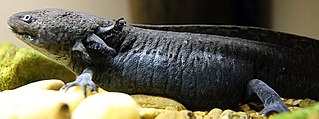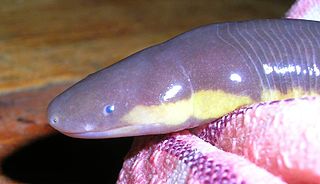
Salamanders are a group of amphibians typically characterized by their lizard-like appearance, with slender bodies, blunt snouts, short limbs projecting at right angles to the body, and the presence of a tail in both larvae and adults. All ten extant salamander families are grouped together under the order Urodela from the group Caudata. Salamander diversity is highest in eastern North America, especially in the Appalachian Mountains; most species are found in the Holarctic realm, with some species present in the Neotropical realm.

The axolotl is a paedomorphic salamander closely related to the tiger salamander. It is unusual among amphibians in that it reaches adulthood without undergoing metamorphosis. Instead of taking to the land, adults remain aquatic and gilled. The species was originally found in several lakes underlying what is now Mexico City, such as Lake Xochimilco and Lake Chalco. These lakes were drained by Spanish settlers after the conquest of the Aztec Empire, leading to the destruction of much of the axolotl's natural habitat.

Plethodontidae, or lungless salamanders, are a family of salamanders. With over 500 species, lungless salamanders are by far the largest family of salamanders in terms of their diversity. Most species are native to the Western Hemisphere, from British Columbia to Brazil. Only two extant genera occur in the Eastern Hemisphere: Speleomantes and Karsenia.

The spotted salamander or yellow-spotted salamander is a mole salamander common in eastern United States and Canada. It is the state amphibian of Ohio and South Carolina. The species ranges from Nova Scotia, to Lake Superior, to southern Georgia and Texas. Its embryos have been found to have symbiotic algae living in and around them, the only known example of vertebrate cells hosting an endosymbiont microbe.

The red-backed salamander is a small, hardy woodland salamander species in the family Plethodontidae. It is also known as the redback salamander, eastern red-backed salamander, or the northern red-backed salamander to distinguish it from the southern red-backed salamander. The species inhabits wooded slopes in eastern North America, west to Missouri, south to North Carolina, and north from southern Quebec and the Maritime provinces in Canada to Minnesota. It is one of 56 species in the genus Plethodon. Red-backed salamanders are notable for their color polymorphism and primarily display two color morph varieties, which differ in physiology and anti-predator behavior.

The Asiatic salamanders are primitive salamanders found all over Asia, and in European Russia. They are closely related to the giant salamanders, with which they form the suborder Cryptobranchoidea. About half of hynobiids currently described are endemic to Japan, but their range also covers parts of china, Russia, Afghanistan and iran.

Ichthyophis is a genus of caecilians found in Southeast Asia, the southern Philippines, and the western Indo-Australian Archipelago.

The alpine salamander is a black salamander that can be found in the French Alps, and through the mountainous range in Europe. It is a member of the genus Salamandra. Their species name, atra, may be derived from the Latin ater, meaning dull black. The salamanders' coloration has evolved over time, as some species are completely monochrome black and others have yellow spotting and marks. Their life expectancy is at least 10 years. There are four subspecies of the alpine salamander, with varied distribution and physical coloration. Unlike other salamanders, whose larvae are developed in water, the alpine salamander and its subspecies are a fully terrestrial species in life and gestation. They give birth to live young.
External fertilization is a mode of reproduction in which a male organism's sperm fertilizes a female organism's egg outside of the female's body. It is contrasted with internal fertilization, in which sperm are introduced via insemination and then combine with an egg inside the body of a female organism. External fertilization typically occurs in water or a moist area to facilitate the movement of sperm to the egg. The release of eggs and sperm into the water is known as spawning. In motile species, spawning females often travel to a suitable location to release their eggs.

Ambystoma rivulare is a species of mole salamander in the family Ambystomatidae. Typically gains a lot of population distribution in the Trans-Mexican Volcanic Belt around central Mexico City. Found in various small or medium-sized ponds and lakes that have large and wide range of food options, all within a distance of at least 2 km. It is endemic to Mexico. Its natural habitats are subtropical or tropical moist montane forests and rivers. It is threatened by habitat loss. The larvae, who continue to prey on the same organisms as they grow, prey mainly on ostracods as well as some gastropods and assorted other prey with limited diversity. Ambystoma rivulare continue to live in the river they hatch in post-metamorphosis. Research on the Michoacan Stream Salamander has important implications for the conservation and persistence of these salamanders. The lack of variety in the A. rivulare diet puts them in a precarious situation should environmental factors endanger the ostracod population in their habitat. Further, a study done at the University of Sao Paulo on the diet of A. rivulare shows no relationship between size and the salamander's diet, suggesting a lack of larger prey for the bigger salamanders to eat.

The Oita salamander is a species of salamander in the family Hynobiidae endemic to Japan. Named after Ōita Prefecture, its natural habitats are temperate forests, rivers, intermittent rivers, freshwater marshes, intermittent freshwater marshes, and irrigated land in western Japan. It is threatened by habitat loss, due to the increasing construction of homes within its habitat. The Oita salamander is considered to be vulnerable by the (IUCN) Red List of Threatened Species with a declining population.

The Ezo salamander, also known as the Hokkaido salamander, Noboribetsu salamander, or Ezo Sanshouo in Japanese is a species of salamander in the family Hynobiidae. Prior to 1923 the species was also classified by the binomial scientific name Satobius retardatus. H. retardatus is endemic to Japan's northernmost prefecture, the island of Hokkaido. The species is a pond-type salamander, and its natural habitats are temperate forests, temperate shrubland, swamps, freshwater marshes, intermittent freshwater marshes, freshwater springs, irrigated land, canals, and ditches.
The amber salamander, amber-colored salamander, tortoiseshell salamander, or Stejneger's oriental salamander is a species of salamander in the family Hynobiidae, endemic to Japan. Its natural habitats are temperate forests and rivers. It is threatened by habitat loss.
The Puxiong salamander is a species of salamander in the family Hynobiidae, endemic to China. It is only known from the vicinity of its type locality, in Puxiong (普雄镇), in Yuexi County, Sichuan Province. The area belongs to the Hengduan Mountains that form the southeastern part of the Qinghai-Tibet Plateau. The Puxiong salamander is a relatively small salamander with a slender body form.

Neverita lewisii, common name Lewis's moon snail, is a species of large operculated sea snail. It is a predatory marine gastropod in the family Naticidae, the moon snails. Traditionally, this species was assigned to either the genus Lunatia, the genus Polinices or the genus Euspira. Recently, it was assigned to the genus Neverita based on molecular data.

Sexual selection in amphibians involves sexual selection processes in amphibians, including frogs, salamanders and newts. Prolonged breeders, the majority of frog species, have breeding seasons at regular intervals where male-male competition occurs with males arriving at the waters edge first in large number and producing a wide range of vocalizations, with variations in depth of calls the speed of calls and other complex behaviours to attract mates. The fittest males will have the deepest croaks and the best territories, with females making their mate choices at least partly based on the males depth of croaking. This has led to sexual dimorphism, with females being larger than males in 90% of species, males in 10% and males fighting for groups of females.

A biological rule or biological law is a generalized law, principle, or rule of thumb formulated to describe patterns observed in living organisms. Biological rules and laws are often developed as succinct, broadly applicable ways to explain complex phenomena or salient observations about the ecology and biogeographical distributions of plant and animal species around the world, though they have been proposed for or extended to all types of organisms. Many of these regularities of ecology and biogeography are named after the biologists who first described them.

Ooperipatellus viridimaculatus is a species of velvet worm in the family Peripatopsidae. This species is oviparous, has 14 pairs of legs, ranges from 30 mm to 50 mm in length, and is brown or orange in color with two rows of green spots along its back. It is found in the South Island of New Zealand.
Countergradient variation is a type of phenotypic plasticity that occurs when the phenotypic variation determined by a biological population's genetic components opposes the phenotypic variation caused by an environmental gradient. This can cause different populations of the same organism to display similar phenotypes regardless of their underlying genetics and differences in their environments.

The Global Species List Working Group (GSLWG) is a non-profit organization and non-governmental organization, founded in 2020, developed under the umbrella of the IUBS with the aim of creating a governance system that imbues global taxon lists with a legitimacy and authority respected by both taxonomists and the users of taxonomy. The organization was developed in response to several publications that demonstrated the need for stability in the names of species. The founding meeting was held in Charles Darwin University in Darwin, Australia in January 2020.


















